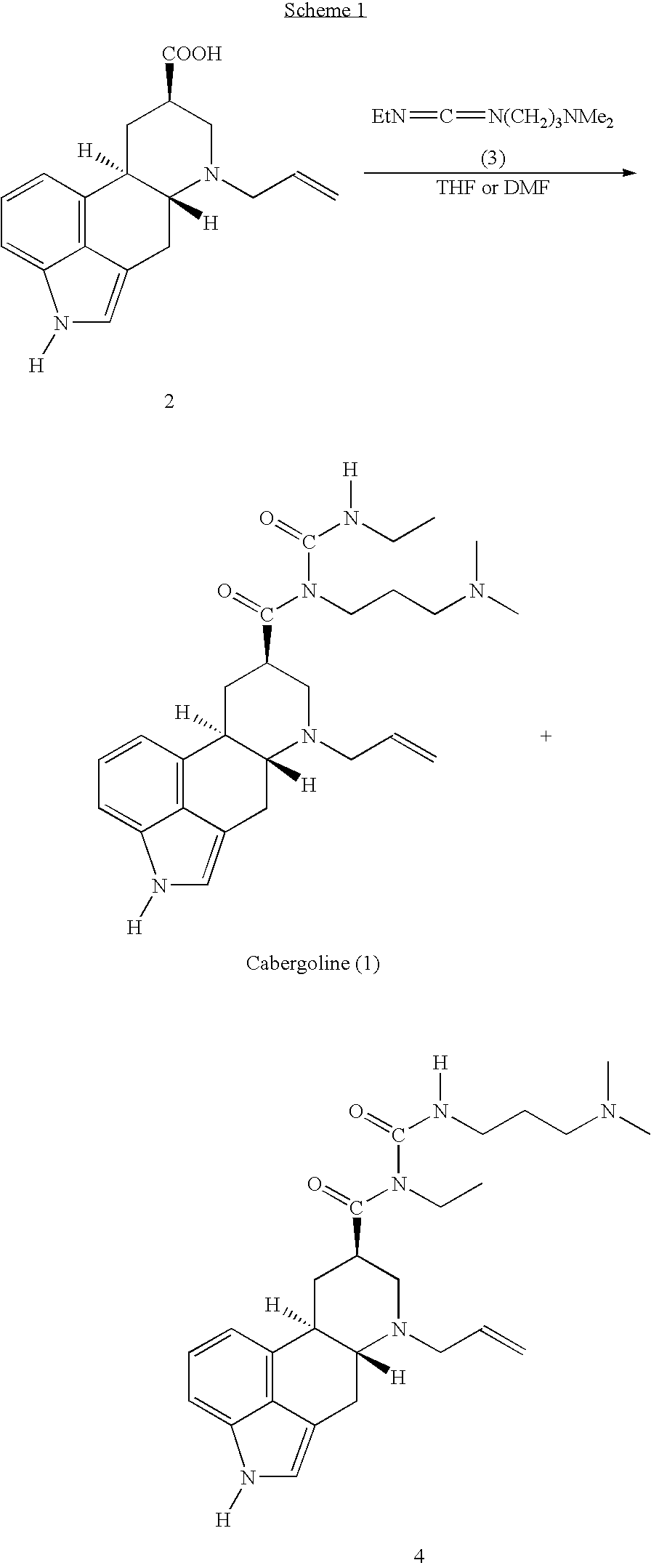New and efficient process for the preperation of cabergoline and its intermediates
a technology of cabergoline and intermediates, applied in the field of new and efficient process for the preperation of cabergoline and its intermediates, can solve the problems of presenting a major limitation for the large-scale preparation of cabergoline, low purity of isolated cabergoline, and use of hazardous ethyl isocyana
- Summary
- Abstract
- Description
- Claims
- Application Information
AI Technical Summary
Benefits of technology
Problems solved by technology
Method used
Image
Examples
example 1
[0034]
[0035]Tert-butyldimethylsilyl chloride (TBS-Cl, 19.6 g) is added into a mixture of Lysergol (30 g) and triethylamine (16.7 g) in N,N-dimethylformamide (150 mL) and the mixture is stirred at room temperature for 2-3 h. The mixture is cooled and water (240 mL) is added. The resulting suspension is stirred for an additional 2 h and then filtered and washed with water. The product is dried under vacuum to give 42 g of 8β-(tert-butyldimethylsiloxymethyl)-9,10-didehydro-6-methyl-ergoline in 96.5% yield.
example 2
[0036]
[0037]A mixture of 8β-(tert-Butyldimethylsiloxymethyl)-9,10-didehydro-6-methyl-ergoline (40 g) and Palladium on carbon (5%, 50% wet, 2.4 g) in N,N-dimethylformamide (200 mL) is hydrogenated at 60-70° C. and 40-50 psi until the theoretical volume of hydrogen has been absorbed. The mixture is allowed to cool and diluted with dichloromethane (160 mL). The reaction mixture is filtered and the insoluble material is washed with more dichloromethane. The filtrate is evaporated to about 140 mL and diluted with water (320 mL). The resulting suspension is cooled and filtered, washed with water and heptanes. The solid is dried under vacuum to give 36.3 g of 8μ-(tert-Butyldimethylsiloxymethyl)-6-methyl-ergoline in 91% yield.
example 3
[0038]
[0039]A mixture of Lysergol (1.5 g) and Palladium on carbon (5%, 50% wet, 75 mg) in N,N-dimethylformamide (15 mL) is hydrogenated at 50-60° C. and 40-50 psi until the theoretical volume of hydrogen has been absorbed. The reaction mixture is cooled, filtered and the insoluble material is washed with more N,N-dimethylformamide. The filtrate is evaporated to dryness and suspended with water. The resulting suspension is filtered, washed with more water. The solid is dried under vacuum to give 1.47 g of dihydrolysergol in 97% yield.
PUM
 Login to View More
Login to View More Abstract
Description
Claims
Application Information
 Login to View More
Login to View More - R&D
- Intellectual Property
- Life Sciences
- Materials
- Tech Scout
- Unparalleled Data Quality
- Higher Quality Content
- 60% Fewer Hallucinations
Browse by: Latest US Patents, China's latest patents, Technical Efficacy Thesaurus, Application Domain, Technology Topic, Popular Technical Reports.
© 2025 PatSnap. All rights reserved.Legal|Privacy policy|Modern Slavery Act Transparency Statement|Sitemap|About US| Contact US: help@patsnap.com



